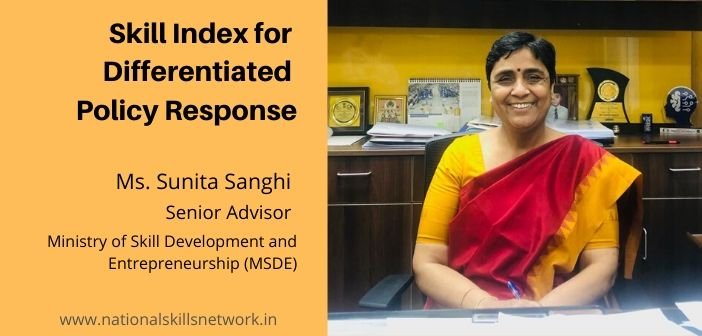In this article, Ms. Sunita Sanghi, Senior Advisor, Ministry of Skill Development and Entrepreneurship (MSDE), establishes the need for Skill Index to measure and monitor the performance of various programs based on certain parameters. The Skill Index would enable the policy makers to identify and resolve various issues at the grassroots level through various performance indicators.
For a country with more than 65% of the population in the working age category, the demographic transition provides an opportunity for rapid growth provided the potential of this human capital is harnessed through appropriate education and skills. Availability of skilled workforce is the key to boost productivity through economic growth and social development of any country. It has been observed that ‘countries with higher and better levels of skills adjust more effectively to the challenges and opportunities of globalization’ (Planning Commission, 2008) and the new age economy. To maximise the use of this potential, Government of India launched the National Skill Mission and set up a dedicated Ministry of Skill Development and Entrepreneurship. The Mission has been supported by progressively higher financial, managerial and evaluation resources among others both by the Central and State Governments. However, it is still constrained by the absence of a strategic real-time monitoring mechanism to assess the impact of several skill training programmes.
The Need For Skill Index
The skill landscape faces challenges two levels. On the one hand, there is an employability challenge wherein the ‘educated’ labour force is not able to find employment matching their aspirational levels due to the mismatch in the skill sets sought by the employer. On the other hand, large sections of the labour force possess no formal skills or education constraining gainful employment and economic productivity. According to the latest PLFS1 survey 2017-18 , current proportion of India’s formally skilled workforce is only 4.69 per cent. The India Skills Report 20192 indicates that 46 per cent of Indian professionals are found ‘employable’. Nearly 92 percent of the workforce is in the informal sector with no formal training or just on-the-job learning. The question, therefore, is not only of fresh skilling but also of up- skilling / re-skilling the existing workforce so as to boost productivity in a labour market where job profiles keep changing with technological advancement. This necessitates focus on life-long learning with skilling, re-skilling and up-skilling as the constituents.
Various measures have been taken to skill the large workforce including long term training through ITIs and short term skilling initiatives through Government schemes like PMKVY3, DDUGKY4 and renewed focus on apprenticeship training. Measures have been taken to improve the standards through competency-based skilling by aligning Qualification Packs (QPs) to National Skills Qualification Framework.
Together with the two flagship short term skilling initiatives, there are more than 20 initiatives in skill development being run by the Government which has focused significant monetary and managerial resources to enhance employability and productivity across the country. However, as different schemes/programmes are being run by various Ministries and departments, a holistic picture of the extent of transformation taking place with respect to skill development and employment is not getting captured.
This necessitates development of a tool that measures the performance of a country’s skills system, in terms of skills development, activation and matching. An ideal measurement tool should be able to gauge the relative performance of States and local skills systems and, in doing so, aims to contribute to the policy discourse on skills, employment, and the labour market. It would help in assessing the match between employers’ needs and future labour market opportunities. Based on the assessment of existing policy initiatives and their outcomes, the future course of policy action can be planned or modified.
The concept of a skills system is multifaceted and complex. There are various dimensions that need to be taken into consideration viz skills development, skills activation and skills matching. The World Indicators of Skills for Employment (WISE) developed by OECD in 2010 identifies five broad indicator domains viz. contextual factors or the main drivers of the skill supplies and demands (aggregate economic conditions, demographics, early childhood development, technology and work conditions, and education and labour-market institutions and policy setting); second and third indicators of skill supply (skills acquisition) and skill demand (skill requirements) which includes stock of human capital in the economy and ongoing investments in the skill formation(educational attainment, literacy, apprenticeships etc.) and indicators for skills requirement include employment shares by education and background and occupation.
The fourth domain of indicators measure how well skills obtained through education and training are matching to the skills required in labour market (proportion of overqualified or under qualified workers, changes in unemployment by education etc) and fifth includes the domain of outcomes measures and the impact on economic performances, labour market outcomes and social outcomes (labour productivity, employment rate, earnings by education and occupation etc.)
In the Indian context, given that the skill ecosystem is in its nascent stage and still evolving, the Skill Development Index (SDI) is envisaged to cover not just the organised sector but also the unorganised sector and to assess the performance of the stakeholders involved in implementing skill development programmes in terms of outcome indicators. The indicators of five key parameters of skill development viz Quality, Relevance, Equity, Access and Finance cut across the pillars of skill development, activation and matching domain. Each of these parameters shall have defined measurable indicators.
 Parameters of skill development index
Parameters of skill development index
Quality
The formal vocational training structure includes vocational education and training in schools at the secondary and senior secondary stage, technical training in specialized institutions such as the ITIs, apprenticeship training and higher technical education imparted through professional colleges. The main issues impacting the functioning of the training institutions in India include outdated curricula, inadequate trainers, lack of training of trainers, non-fulfillment of trainers’ vacancies, lack of training infrastructure, absence of industry clusters nearly leading to isolation of ITIs, under-utilization of seating capacity, un-employability of trained graduates etc. There is an acute shortage of qualified trainers/instructors. It is estimated that with an average trainee instructor ratio of 20:1, more than 80,000 instructors are required to meet the demand for enhancing skill development target.
The improvement in quality aspects requires looking into Student-Instructor Ratio; Proportion of Certified Instructors; Proportion of Students Certified through Training Programmes; Drop out Percentage; Rate of National Skills Qualifications Framework (NSQF) Compliance; Long-term employability of trained students; and employment rate of graduates and taking necessary course correction measures.
Relevance
As India moves progressively towards becoming a ‘knowledge economy’, the focus needs to be on advancement of skills relevant to the new age economy. In order to achieve the twin targets of economic growth and inclusive development, India’s GDP has to grow consistently at 8% to 9% per annum. This requires significant progress in several areas, including infrastructure development, agricultural growth coupled with productivity improvements, financial sector growth, a healthy business environment, ably supported by a skilled workforce. The advent of Industry 4.0 requires skill sets that are quite different implying a large skill gap especially among those migrating from agriculture to other sectors. This scenario necessitates dedicated interventions in skilling of our workforce. However, given the preponderance of informal sector in the economy it is difficult to map the skill requirement and develop marketable skills.
Increasing urbanization and advent of digital technologies has opened up doors for micro-entrepreneurs to participate in the gig economy. This also opens requirement for people able to leverage technology and adapt to the various opportunities coming from this transformation. Further with global competition and thrust on efficiency and quality improvement, demand induction of qualified as well as certified trainees in the industry is constantly rising. Therefore for creating industry relevant workforce, it is necessary to capture the Proportion of Skilled Workers in the Formal sector; Proportion of Skilled Workers in the Informal Sector; Proportion of Skilled Unemployment; Proportion of Apprentices in an Establishment; Earning Differentials between Employees with Vocational Training vis-à-vis those who haven’t been trained; Quality of Entrepreneurship Development Programme; Skill Shortage; Proportion of overqualified and underqualified workers and Relative Weight of Skill training within the Formal Education System.
Equity
The National Skill Development Mission mandates skill training of the heterogeneous labour force consisting of youth, women, school dropouts, disabled, minorities and tribal groups irrespective of any economic, social, regional, gender, spatial and sectoral divide to achieve faster and inclusive growth and for development of a just and equitable society. Women constitute about 48.5 per cent of the population and have an important role to play in the growth of the economy. However, their work participation rate has been declining, thus limiting their employment options, economic returns and long-term career development. It would be important to examine their participation in vocational training as well as outcomes of training for their employment prospects. The key indicators are Gender Ratio in Training Programmes; Proportion of Students from various social groups and minorities in Vocational Training Programmes; and Proportion of Differently abled Persons enrolled for Vocational Training Programmes.
Related reading: An interview with Ms. Sunita Sanghi on how skills connect education with labour market and economy – Read more: https://nationalskillsnetwork.in/skills-labour-market-and-economy/
Access
Skill training is marred by multiple access barriers like limited infrastructure facilities, quality of training, lack of financial support and negative perceptions. These shortcomings exist more for the disadvantaged, especially women and rural communities. India has a very large geographical spread, difficult terrain and varying socio-economic conditions which make implementation of standardised, quality controlled skill instruction a huge challenge. Various skill development programs of GoI have largely addressed the issue of finance by offering government funded/subsidized access to training courses. The measurement of access can be gauged from Seating Capacity of Vocational Training per thousand population; Training Capacity of Institute vis-à-vis Output Proportion of Trained Youth in Rural Areas; and Persons with Recognition of Prior Learning (RPL) Certificate and Neither in Education, Employment and Training (NEET).
Financing of skill development
Availability and accessibility of finance can be a decisive factor in the smooth functioning of a programme. The National Skill Development Fund (NSDF) was set up with the objective of encouraging skill development in the country. As public funds are limited, this fund acts as a receptacle for all donations in cash or kind from all the stakeholders including Government-both at Centre and State, the enterprises-public and private and the direct beneficiary and multilateral organisations. The fund meets its objective through National Skill Development Corporation (NSDC) which is a not-for-profit-company set up for skill building and forging market links. NSDC provides funding to private companies and organisations that provide skill training.
The Credit Guarantee Fund for skill Development and a ‘National Credit Guarantee Trustee Company’ (NCGTC)’ has been set up to support the initiative of loans for the purpose of skilling and credit financing. On similar lines, a Credit Guarantee Fund for Entrepreneurship Development worth Rs. 3000 crore has been initiated under PM Mudra Yojana through NCGTC. The financing indicator here would evaluate this fund utilization pattern. Indicators in this section would evaluate the availability of financial resources at the level of the students and system; Per capita cost of training in a year; Proportion of public and private expenditure for skilling; Proportion of Credit Guarantee Fund Utilized; and Proportion of Students who availed Financial Assistance.
Conclusion
The skill delivery ecosystem developed over the last decade is a Centre driven top-down approach to address a massive shortfall in supply of skilled people and a massive expansion of economic activity which coincided with this period. It is being progressively decentralised by greater say of States in policy formulation and further by decentralising planning level activities to the district level. Further convergence to cover the Gram Panchayat level shall be the next logical extension.
In light of a varied trajectory followed in the skill ecosystem, the skill index shall enable policymaker to identify micro level gaps in demand, mobilisation, infrastructure, counselling etc. which needs addressal at the ground. The Skill Index would reveal the true performance of skills systems not only at the National level but the State and local level. The indicators would facilitate differentiated approach in different geographic regions depending on the results. It would provide policy-makers a bird eye view of areas where efforts needs to be focussed.
References
[1] Periodic Labour Force Survey
[2] India Skills Report is a joint initiative by HR firms PeopleStrong and Wheebox in collaboration with CII, UNDP, AICTE and AIU
[3] Pradhan Mantri Kaushal Vikas Yojana is a skill development scheme of the Government of India for recognition and standardisation of skills and is administered through the Ministry of Skill Development & Entrepreneurship
[4] Grameen Kaushalya Yojana or DDU-GKY is a Government of India youth skills and employment scheme launched in 2014. It is administered by the Ministry of Rural Development.
Subscribe to our YouTube channel for more updates:
Subscribe on YouTube













Comments 1